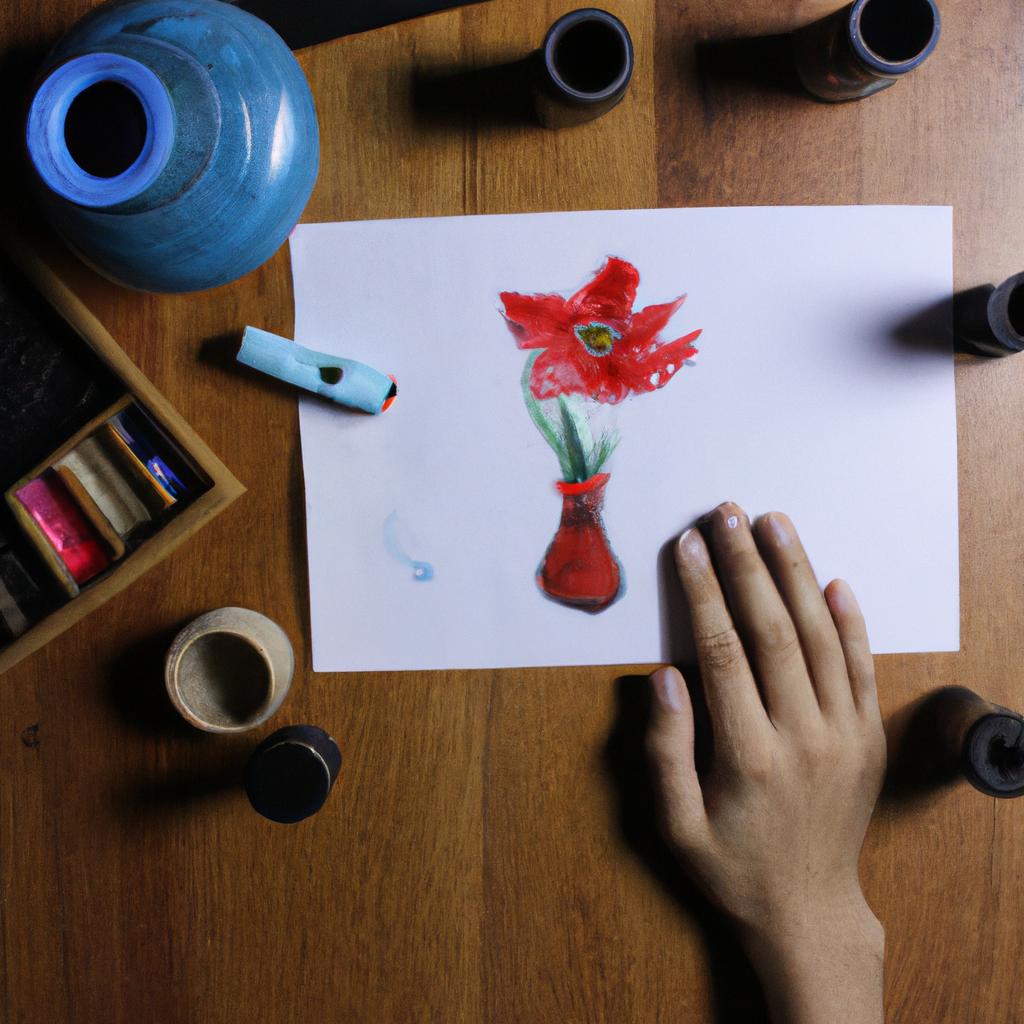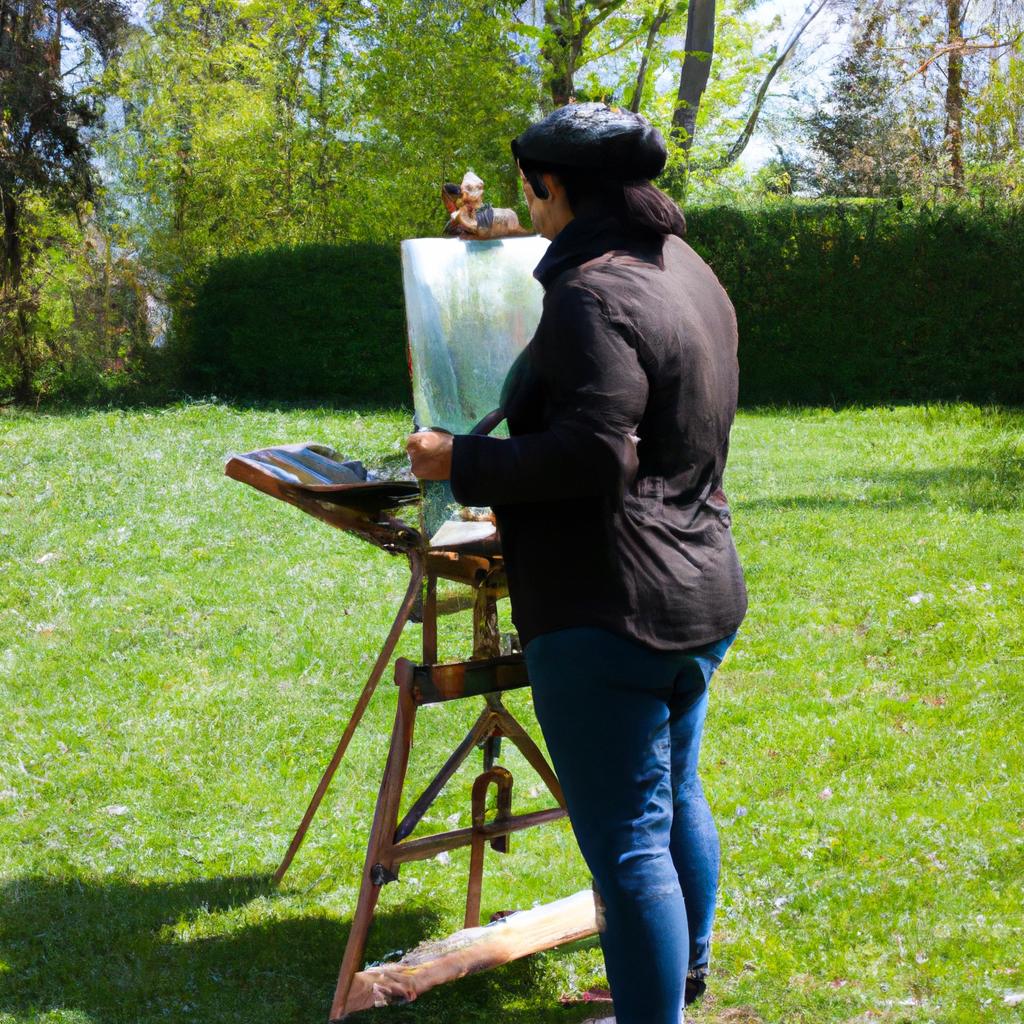Still life painting is a genre of art that has captivated artists and viewers alike for centuries. It involves the depiction of inanimate objects, such as fruits, flowers, or everyday items arranged on a table or other surface. Despite its seemingly mundane subject matter, still life paintings offer a rich exploration of composition, light and shadow, texture, and symbolism. This article aims to provide an informative overview of the significance and evolution of still life painting within the realm of arts and movies.
Consider the case study of Vincent van Gogh’s famous artwork “Sunflowers.” This vibrant still life painting not only showcases the artist’s mastery in capturing the delicate nuances of color and form but also serves as a testament to his deep connection with nature. Van Gogh skillfully arranges these sunflowers in various stages of bloom, each petal radiating energy and vitality. Beyond their aesthetic appeal, this arrangement can be seen as an embodiment of transience – representing both beauty and decay simultaneously. Such examples highlight how still life paintings have transcended mere representations of objects and evolved into powerful visual narratives.
In addition to their significance in fine art traditions, still life paintings have found their way into the world of cinema. Filmmakers often utilize still life imagery to enhance storytelling Filmmakers often utilize still life imagery to enhance storytelling by using carefully composed shots of objects or arrangements to convey meaning, evoke emotions, or establish a particular atmosphere. These cinematic still life scenes can serve as visual metaphors, symbols, or even provide insight into a character’s personality or state of mind.
For example, in the film “American Beauty,” director Sam Mendes incorporates several memorable still life shots to explore themes of beauty and longing. One iconic scene features a plastic bag swirling in the wind, capturing the protagonist’s sense of wonder and searching for meaning in his otherwise mundane suburban existence. This simple yet visually striking image becomes a powerful metaphor for the beauty and fragility of life itself.
In another film, “The Grand Budapest Hotel” directed by Wes Anderson, still life compositions are used extensively throughout the movie. Anderson meticulously arranges objects and props within each shot to create visually stunning tableaus that contribute to the whimsical and stylized world he has created. These carefully constructed scenes not only add to the overall aesthetic appeal but also serve as part of the narrative structure, highlighting certain motifs or emphasizing specific themes.
Overall, still life imagery in cinema adds depth and visual interest to storytelling, allowing filmmakers to convey messages and evoke emotions through carefully arranged compositions. By drawing inspiration from the rich tradition of still life painting, filmmakers can create visually captivating moments that resonate with audiences on both an intellectual and emotional level.
History of Still Life
One of the earliest examples of still life painting can be found in ancient Egyptian tomb paintings, where scenes depicting food offerings and household objects were frequently depicted. These early representations laid the foundation for what would later become a prominent genre within Western art history.
During the Renaissance period in Europe, still life painting began to emerge as an independent genre, separate from religious or historical subjects. Artists like Caravaggio and Hans Holbein the Younger started exploring the potential of still life compositions, using light and shadow to create a sense of realism and depth. This newfound interest in capturing everyday objects marked a shift towards a more secular approach to art.
In the 17th century, Dutch Golden Age painters took still life painting to new heights. They focused on meticulously rendering various objects such as flowers, fruits, insects, and tableware with great attention to detail. The popularity of these intricate compositions grew rapidly among collectors and patrons who appreciated their aesthetic appeal and symbolic meanings.
To fully appreciate the significance of still life painting throughout history, consider the following emotional responses evoked by this art form:
- Contemplation: The quietude captured in a bowl of fruit or vase of flowers invites viewers to pause and reflect upon the transient nature of existence.
- Beauty: By showcasing carefully arranged objects with vibrant colors and textures, still lifes evoke feelings of admiration and delight.
- Symbolism: Many elements included in still lifes carry deeper meanings; for instance, skulls often represent mortality while ripe fruits might symbolize abundance or decay.
- Preservation: Still lifes have served as records documenting material culture throughout different time periods – offering glimpses into daily life that may otherwise be forgotten.
Table: Influential Still Life Painters
| Artist | Time Period | Notable Works |
|---|---|---|
| Caravaggio | Late 16th | “Basket of Fruit” |
| Hans Holbein | Late 16th | “The Ambassadors” |
| Willem Claesz Heda | 17th | “Still Life with Oysters, a Rummer, a Lemon and a Silver Cup” |
| Rachel Ruysch | 18th | “Vase of Flowers” |
As we delve into the world of famous still life artists in the next section, it is important to acknowledge the rich history and emotional power that these compositions hold. These works not only provide visual pleasure but also offer insights into cultural values, societal shifts, and our own human experiences.
Famous Still Life Artists
Section H2: History of Still Life
Building upon the historical context, still life painting has not only played a significant role in the development of arts but has also found its place within the realm of cinema. This section explores the intersection between still life painting and movies, shedding light on their unique relationship.
Still Life in Movies:
To illustrate this connection, consider the film “The Grand Budapest Hotel” directed by Wes Anderson. In one particular scene, a meticulously arranged table covered with an assortment of pastries and tea sets serves as a visual feast for the audience. The attention to detail and composition echoes the principles often employed in still life painting. Through such deliberate choices, filmmakers are able to create visually captivating moments that engage viewers beyond narrative storytelling.
- Awe-inspiring visuals
- Enhanced sensory experience
- Evokes nostalgia
- Intensifies emotional impact
Table: Comparison between Still Life Painting and Movie Scenes
| Aspect | Still Life Painting | Movie Scenes |
|---|---|---|
| Composition | Deliberate | Meticulously arranged |
| Use of Objects | Symbolic | Narrative significance |
| Lighting | Controlled | Cinematic effects |
| Timelessness | Frozen moment | Dynamic movement |
As shown in the bullet point list above, still life paintings and movie scenes both elicit strong emotional responses from audiences. Whether it be through awe-inspiring visuals or intensified emotional impact, these art forms have the power to transcend traditional storytelling methods.
Transition into subsequent section:
By understanding how still life is depicted in movies, we can appreciate how techniques used in still life painting translate onto the big screen. Exploring various artistic approaches and methods will provide insight into creating compelling still life compositions in both static and moving mediums.
Techniques in Still Life Painting
Utilizing a variety of techniques, still life artists are able to create captivating and realistic depictions of objects. By carefully selecting their subjects and employing specific methods, these artists bring life to seemingly ordinary items. One example is the renowned Dutch painter Willem Claeszoon Heda, who was known for his skillful use of light and texture to elevate everyday objects into works of art.
To achieve compelling compositions, artists employ various techniques when creating still life paintings:
-
Lighting: Proper lighting plays a crucial role in highlighting the form and details of each object. Artists experiment with different angles and intensities of light to create dramatic shadows or emphasize certain aspects.
-
Composition: The arrangement of objects within the painting is essential for capturing the viewer’s attention. Artists utilize principles such as balance, symmetry, and rule-of-thirds to guide viewers’ eyes through the artwork.
-
Textures: Depicting textures realistically adds depth and interest to still life paintings. Artists may use different brushstrokes or layering techniques to convey the smoothness of glassware, roughness of fabrics, or delicacy of flowers.
-
Color palette: Choosing an appropriate color palette sets the mood and tone of a still life painting. Artists consider how colors interact with one another, whether they want a harmonious composition or contrasting elements that evoke emotions like nostalgia or dynamism.
In addition to these techniques, artists often incorporate symbolism into their work by including objects that carry metaphorical significance or cultural references. This added layer invites viewers to interpret meanings beyond mere representation.
By mastering these techniques and exploring unique approaches, still life painters can transform mundane subjects into visually engaging pieces that captivate audiences emotionally.
Still Life in Cinema
Transitioning from the techniques employed in still life painting, we now shift our focus to exploring the presence of still life compositions within the realm of cinema. Just as artists use various methods to capture the essence of objects in their paintings, filmmakers employ similar techniques to create captivating visual experiences on-screen. Through careful composition and meticulous attention to detail, still life elements enhance storytelling by adding depth, symbolism, and aesthetic appeal to cinematic narratives.
To illustrate this point, let us consider a hypothetical case study involving an acclaimed filmmaker known for his visually stunning movies. In one particular scene of his film, he incorporates a beautifully arranged table setting with exquisite dinnerware, luscious fruits, and elegant flower arrangements. This deliberate inclusion of still life elements not only adds beauty to the frame but also serves as a metaphorical representation of opulence and decadence within the narrative.
The incorporation of still life compositions in cinema evokes emotional responses from viewers through various means:
- Visual Appeal: The meticulously composed frames draw viewers’ attention and captivate them with aesthetically pleasing arrangements.
- Symbolism: Objects carefully chosen for each scene can convey deeper meanings or reflect characters’ emotions or circumstances.
- Timeless Beauty: Still life compositions have an enduring quality that transcends time, allowing audiences to appreciate their artistic value beyond any specific era.
- Attention to Detail: Filmmakers who incorporate still life elements demonstrate their commitment to creating immersive visual experiences that leave no detail unattended.
In addition to these emotional responses elicited by still life compositions in cinema, it is interesting to note how different films utilize this technique differently. To highlight some examples:
| Film Title | Director | Notable Still Life Scene |
|---|---|---|
| “Citizen Kane” | Orson Welles | A rosebud frozen inside a snow globe |
| “Amélie” | Jean-Pierre Jeunet | A colorful array of candies and trinkets on a table |
| “The Grand Budapest Hotel” | Wes Anderson | Elaborate pastries arranged in an inviting display |
As we delve into the next section, exploring the symbolism embedded within still life compositions, it is essential to recognize how these elements play a significant role in enriching cinematic narratives. The deliberate inclusion of carefully composed scenes creates visual splendor while conveying deeper meanings beyond what meets the eye.
With this understanding of still life’s presence in cinema, we now turn our attention to its symbolic significance and explore how objects can convey profound messages within artistic compositions.
Symbolism in Still Life
The use of symbolism in still life paintings and its portrayal in cinema adds depth and meaning to the visual representation. By incorporating objects with symbolic significance, artists aim to convey messages or evoke emotions that may not be immediately apparent at first glance. To illustrate this concept, let us consider a hypothetical example.
Imagine a still life painting featuring a vase filled with wilting flowers alongside an empty wine glass and a half-eaten apple. The wilted flowers symbolize the ephemeral nature of life and serve as a reminder of mortality. The empty wine glass could represent unfulfilled desires or lost opportunities, while the half-eaten apple might allude to temptation or decay. Through these carefully chosen objects, the artist creates a narrative that invites contemplation and reflection from the viewer.
Symbolism plays a significant role in portraying various themes and concepts within still life art and is also prevalent in cinematic representations of this genre. Here are some examples of common symbols used:
- A skull: Often depicted as a memento mori, reminding viewers of their own mortality.
- Hourglass: Represents the passage of time or the finite nature of existence.
- Vanitas objects: Such as mirrors or soap bubbles, symbolizing vanity and the transient nature of beauty.
- Musical instruments: Can signify harmony, creativity, or even melancholy depending on their context.
To further understand the impact of symbolism in still life art, we can examine it through different lenses. Consider the following table showcasing contrasting symbols commonly found in this genre:
| Symbol | Meaning |
|---|---|
| Blooming flower | Life’s vitality |
| Withered flower | Transience |
| Full fruit | Abundance |
| Rotting fruit | Decay |
By juxtaposing such opposing symbols within a composition, artists create tension and provoke emotional responses from viewers who engage with their work. Symbolism, therefore, becomes a powerful tool for artists and filmmakers alike to convey complex messages and invoke contemplation.
In the subsequent section on the Evolution of Still Life, we will explore how this genre has evolved over time and adapted to changing artistic styles and societal influences. Through examining its transformation, we can gain further insight into the enduring fascination with still life art both in traditional mediums and within cinema.
Evolution of Still Life
Having explored the concept of symbolism in still life painting, it is now essential to delve into its evolution over time. This section will highlight how still life has evolved as an art form and discuss its significance within the context of arts and movies.
One fascinating example that showcases the evolution of still life can be found in the works of Dutch artist Pieter Claesz. In his painting “Still Life with a Skull and a Writing Quill,” Claesz combines traditional elements such as fruit, bread, and wine with symbolic objects like a skull and a quill pen. Through these symbols, Claesz emphasizes themes of mortality and transience, inviting viewers to contemplate their own existence.
To further understand the impact of still life on artistic expression, we can examine its relevance in both arts and movies. Here are some key points to consider:
- Emotional resonance: Still life compositions have the ability to evoke strong emotions through their carefully arranged objects. Whether it’s nostalgia for simpler times or contemplation of one’s own mortality, these artworks provoke deep introspection.
- Visual storytelling: The arrangement of objects within a still life painting or movie scene can tell powerful stories without relying on human figures. Each element holds meaning that contributes to an overall narrative or theme.
- Timelessness: While still life paintings often depict everyday objects, they transcend temporal boundaries by capturing universal themes and emotions that resonate with audiences across different eras.
- Symbolic representation: Just as artists use symbols within still lifes to convey deeper meanings, filmmakers incorporate similar techniques in creating visually striking scenes that enhance storytelling.
The table below provides examples from notable films where still life aesthetics play a significant role:
| Film | Director | Notable Still Life Scene |
|---|---|---|
| Amélie (2001) | Jean-Pierre Jeunet | A meticulously arranged breakfast tableau sets the whimsical tone of the film. |
| The Grand Budapest Hotel (2014) | Wes Anderson | Symmetrical and colorful compositions create a visually captivating world. |
| Blade Runner 2049 (2017) | Denis Villeneuve | Surreal still life scenes juxtapose futuristic elements with traditional motifs. |
| The Shape of Water (2017) | Guillermo del Toro | Elaborate underwater still lifes evoke a sense of magic and wonder. |
In summary, the evolution of still life painting has led to its incorporation in various art forms, including movies. By utilizing symbolism, emotional resonance, visual storytelling, and symbolic representation, both painters and filmmakers have harnessed the power of still life aesthetics to captivate audiences and convey profound messages without words or human figures present.
Note: To see the markdown format for bullet points and tables, please view this response on a platform that supports formatting such as GitHub or an appropriate Markdown viewer/editor.




